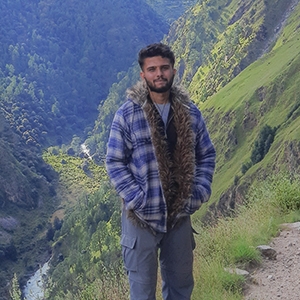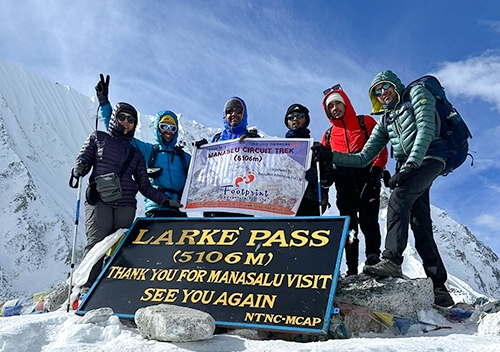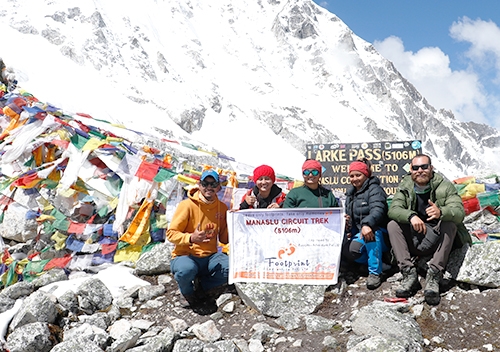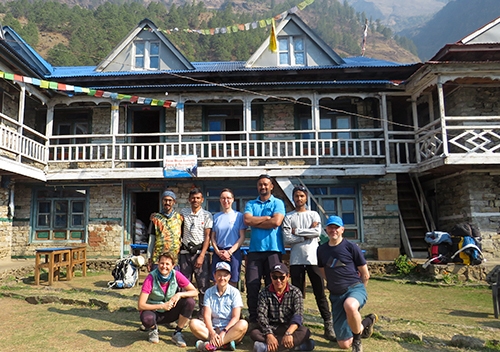The Introduction of Manaslu Circuit Trek
Manaslu Circuit Trek is one of the most renowned, a bit off-the-beaten-path, least discovered, less crowded, and naturally rich and diverse trekking trails in Nepal. Popular trekking trails like Everest Base Camp Trek, Annapurna Base Camp Trek, and Manaslu Circuit Trek are also getting popular these days. The trail starts from the low land to the lower Himalayan region to the high mountains and reaches another climatic atmosphere, giving a glimpse of diverse culture, traditions, people, and natural beauty. Following the pristine Budigandai river from the beginning of the trek, visiting traditional villages of ethnic people, and enjoying the fresh atmosphere of the mountains will be the most cherishing parts of this trek. Trekking in the Manaslu Region offers enchanting mountain scenery and magical landscapes that offer a lifetime experience to explore the hidden beauties of Nepal.
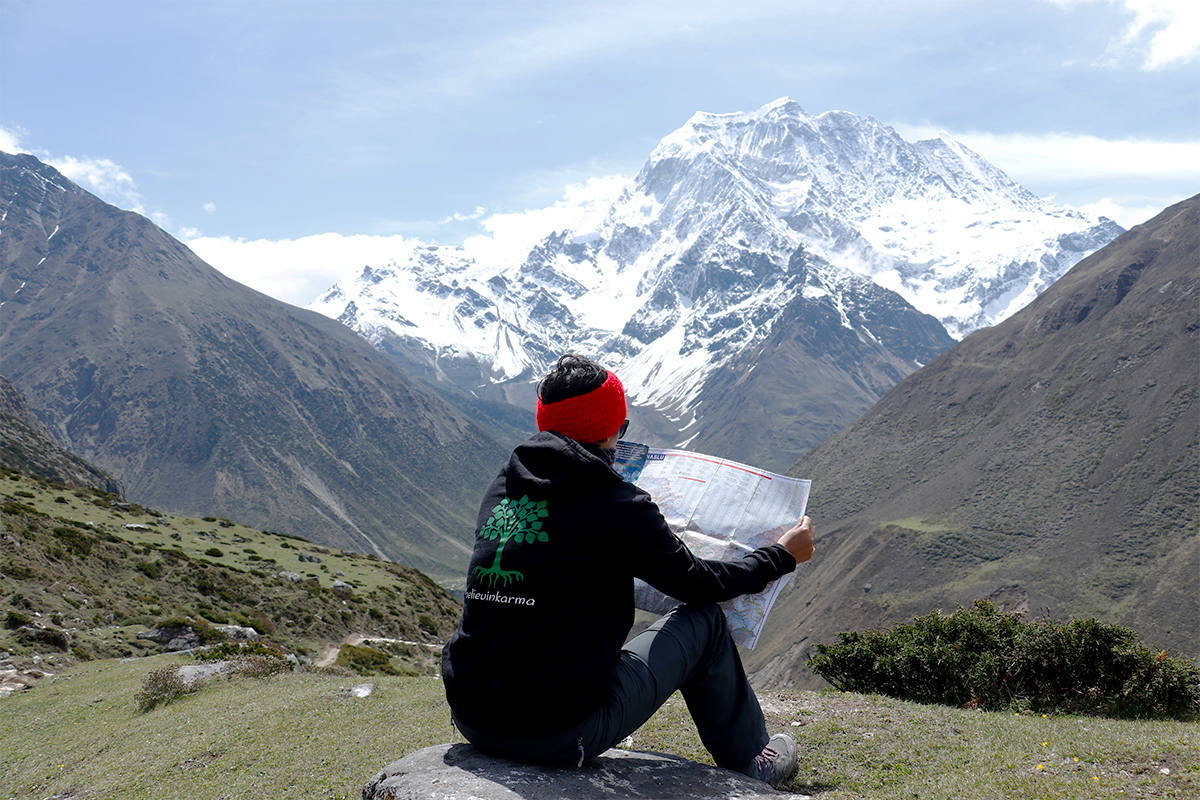
The Manaslu Circuit trek begins with the scenic and beautiful drive from Kathmandu to Soti Khola and crosses several beautiful villages, terraced rice fields, and heads through the lush forests from subtropical to alpine altitude. Following the Budi Gandaki river, passing several villages like Machha Khola, Dovan, Philim, Deng, Namrung, Sama Gaun, Samdo, and finally crossing Larkey La pass before reaching Bhimangthang, The trail covers dense forest, alpine forest, rice terraces, farmlands, valleys, and beautiful landscapes across the entire circuit. The Larke La Pass (5106m) is the highest elevation and the last Himalayan pass of the trek in the Manaslu region. The stunning views of Manaslu, Himal Chuli, Ngadi Chuli, Shringi, and Larkey glaciers, along with the Annapurna Range and Lamjung Himal Range, are the best part of this trail. The trekking trails are distinct and rich in flora and fauna.
Why is the Manaslu Region a restricted area?
Manaslu, which means the “Mountains of the Spirit", is also known as the "Killer Mountain" in the world of mountaineering. The trail is less motivated and less directed than trekking trails in Nepal. For trekking, expeditions, and any other kind of adventure activity, you must get a special permit to enter the Manaslu region, especially from Jagat ( Gorkha) to Dharapani (Manang), listed inside the restricted zone by the Government of Nepal. The practices, customs, and way of life in the Manaslu region are exceptional and not similar to those in the other societies of Nepal. Similarly, the people of this region have stayed flawless and unadulterated. Thus, to control the flow of travelers as well as spare the authenticity of the locals, this region is one of the restricted zones in Nepal.
Why trek in the Manaslu Region?
The Manaslu region is rich in culture, biodiversity, natural beauty, ethnic people, diverse terrain, amazing landscapes, and all the elements that one travels enthusiastically to look for. The Buddhist culture, rich wildlife, raging rivers with numerous suspension bridges, greenery, and the exceptional view of the snow-capped mountains make Manaslu a top trekking destination in Nepal. The Manaslu region is covered by the Manaslu Conservation Area, with an area of 1663 square kilometers, which was declared in 1998. The region is also the home of numerous endangered animals such as red pandas, snow leopards, Himalayan Tahr, black bears, musk deer, blue sheep, and clouded leopards. In the Manaslu Region, there are more than 110 species of birds, 35 species of mammals, and 3 species of reptiles found here.
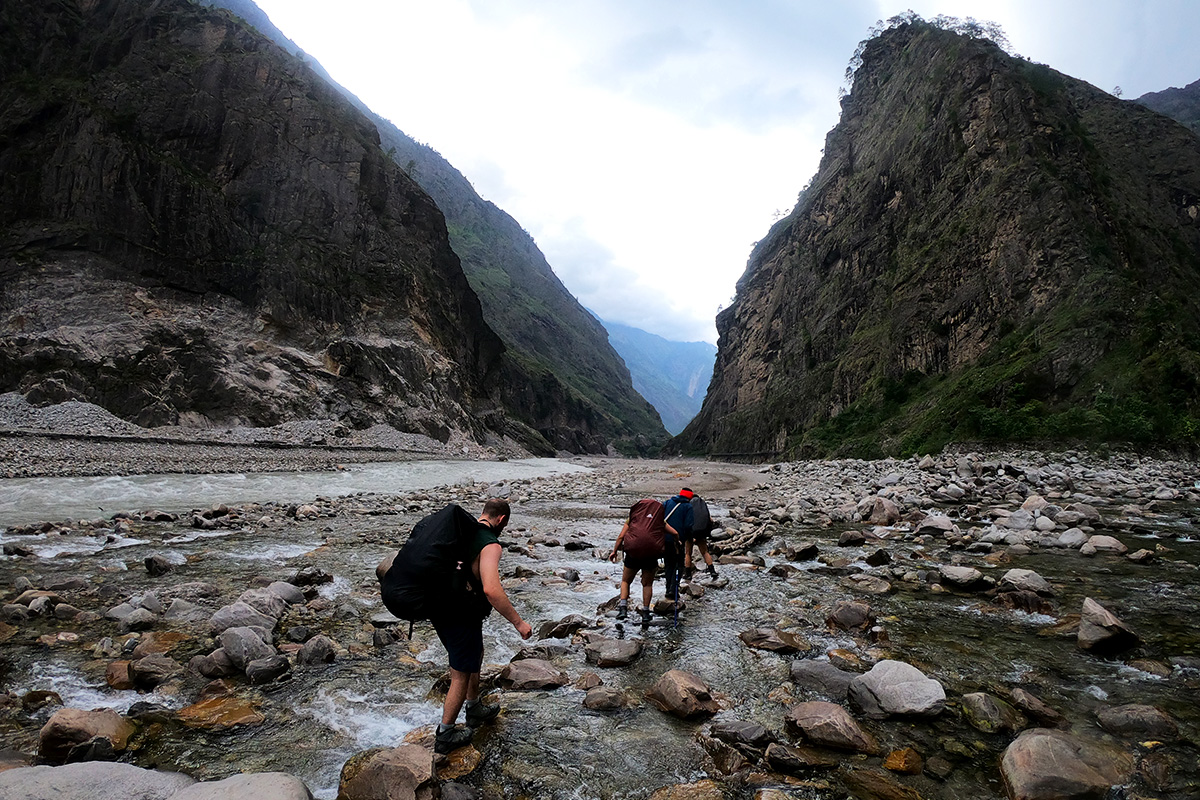
Besides these, the Nubri, Tsum, Bhutias, and Gurung ethnicities are the major ethnic inhabitants of the Manaslu region who have been living there for more than 700 years. The culture and practice are quite seamless with Tibetan culture as most of the parts are connected to the Tibet border. The region allowed trekking in Manaslu after 1991, and it’s getting popular as tea house trekking in Nepal.
Highlights of the Manaslu Circuit Trek
- It is a scenic and beautiful drive from Kathmandu to Soti Khola.
- Explore the rich culture of Buddhist and Hindu people.
- Explore the beautiful traditional villages such as Namrung, Samagaon, Samdo, Shyala, and many more.
- Discover your spiritual self in the region's most well-known monastery, Lho Gaun-Ribung Gompa, and collect the colorful collection of religious artwork.
- Explore one of the least explored trekking trails where you can experience the Tibetan culture, lifestyle, practices, and customs.
- Explore the diverse exotic flora and fauna in the restricted Manaslu Conservation Area.
- traversing numerous suspension bridges, walking alongside the Budi Gandaki river and a dense forest of rhododendron and biodiversity.
- Stunning views of Mt. Manaslu, Himalchuli, Ganesh Himal, Himlung, Annapurna Himalayan range, and many more snow-capped mountains.
- Larkey Pass (5,106m), is the highest point on the trek.
- Explore the beauty of Birendra Lake, Pungen Gompa, Manaslu Base Camp, and Punkar Lake.
- Experience trekking in rugged terrain, amazing landscapes with beautiful mountain views, pastured land, and riverside walks.
How long is the Manaslu Circuit Trek?
The entire Manaslu Circuit trek is 14 days from Sotikhola to Dharapani. The total distance of the Manaslu Circuit Trek from Machha Khola to Dharapani is 160km approximately. However, the distance is different from the starting point and ending point that you’ll choose. The above-mentioned days and distance is the standard trekking route which is relevant for all trekkers. During your Manaslu Circuit trek, you’ll walk 5-7 hrs daily, 15-20km distance, and cover 350-500, elevation daily on an average. You will stroll for around 5-6 hours every day. Overall, every day you will gain around 450-500m elevations. You will cover around 10-15 km of distance each day. The Manaslu Circuit Trek is a bit tiring and exhausting in terms of daily distance as compared to other popular trekking trails in Nepal. However, the proper guidance and preparation before the trip will definitely reduce the difficulty and make your trip more pleasant.
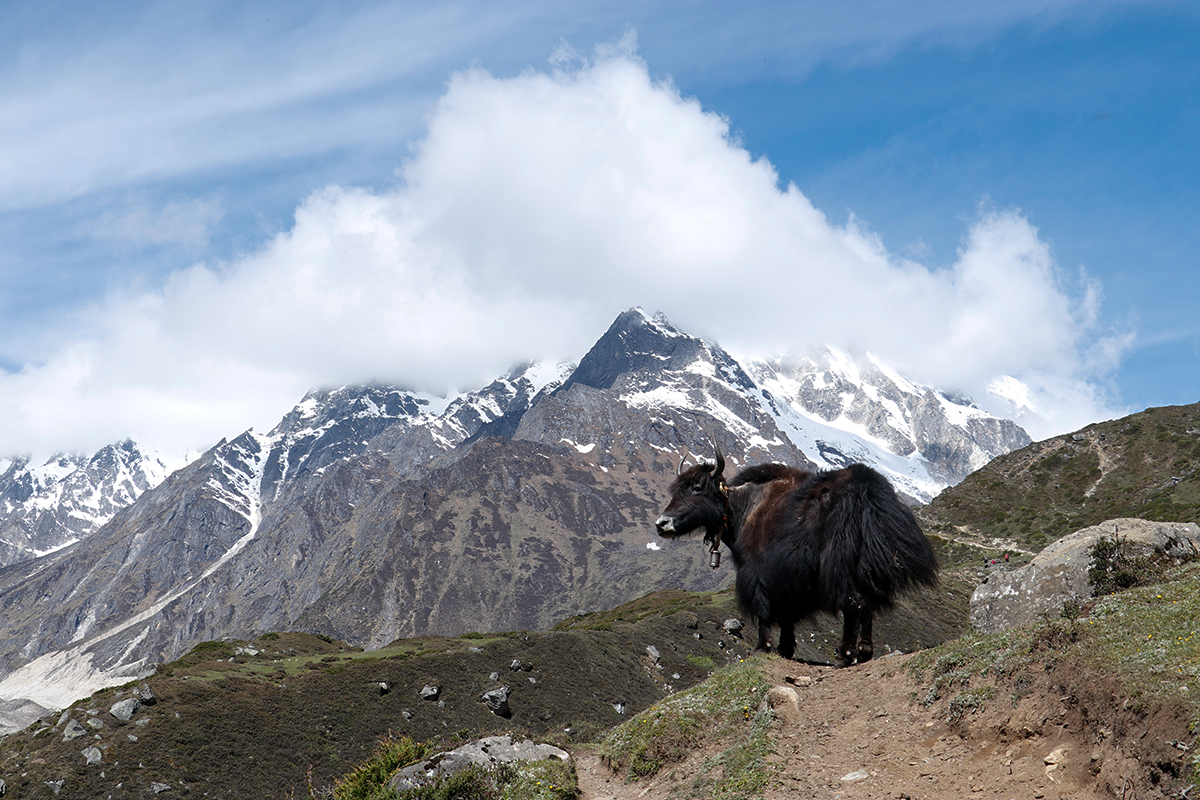
The Regular Itinerary for the Manaslu Circuit Trek
- Day 1: Drive to Soti Khola/Machha Khola
- Day 2: Trek to Jagat
- Day 3: Trek to Deng
- Day 4: Trek to Namrung
- Day 5: Trek to Shyala
- Day 6: Trek to Samagaun
- Day 7: Acclimatization Day
- Day 8: Trek to Samdo
- Day 9: Acclimatization Day
- Day 10: Trek to Dharamshala/ Larkey Phedi
- Day 11: Trek to Bimthang via Larkey Pass
- Day 12: Trek to Tilicho
- Day 13: Trek to Dharapani and drive to Besisahar
- Day 14: Drive back to Kathmandu
How difficult is the Manaslu Circuit Trek?
Two weeks of Manaslu Circuit Trek is equally challenging and rewarding as you've got to complete a 175km circuit. This is a physically demanding trek that requires a bit of This includes activities such as a small hike, jogging, cardio exercise, and some yoga and breathing exercises that will help to succeed on this trek. Exercising and jogging regularly for a couple of weeks before departure is a good idea to enhance your stamina. Past hiking and trekking experience would be an added advantage for the Manaslu trek, but technical skills are not necessary to complete this trek. Trekkers who are able to hike 5-8 hours a day at a reasonable pace can join this trip.
The trail will pass through rocky paths, mountain terrain, steep ascents, descents, forest, suspension bridges, and alpine vegetation on the way. The trekkers with prior medical conditions for lung, heart, or blood diseases have to inform us or consult with their own medical personnel before booking the trip. Besides this, you must have an idea of high altitude sickness, the condition of trekking trails, mountain climate, and atmosphere to make sure the trekking will be smoother.
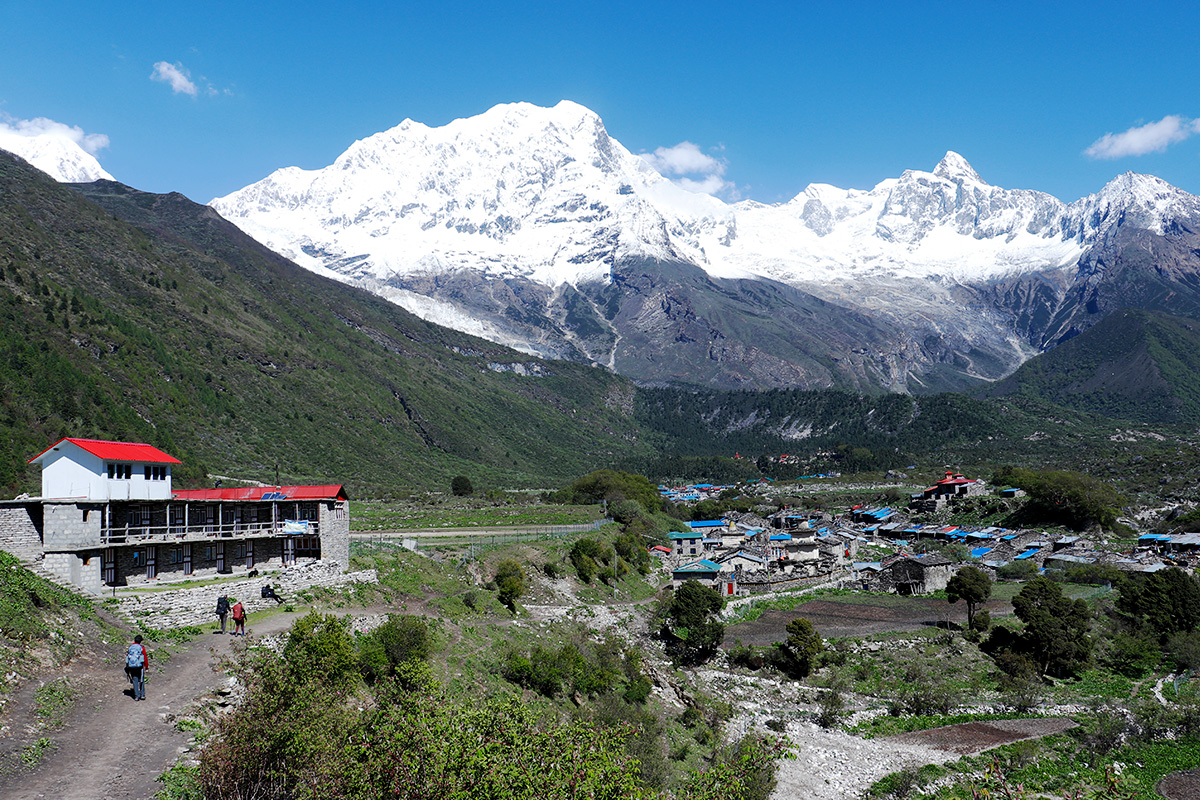
How much does it cost to do the Manaslu Circuit Trek?
A two-week trek normally costs 1600 to 2000 USD, which includes all the ground transportation, trekking permits, special permits, a full-board meal ( breakfast, lunch, and dinner), a professional trekking guide and porter, accommodations during the trek, and a few days in Kathmandu, a trip completion certificate, a city tour, and a welcome dinner. Handsome discounts are made if you travel in a group.
Besides this, the cost of the Manaslu Circuit Trek depends upon the customization of the trip; traveling in a group or privately; and the season that you’ll choose also makes some difference in price. Traveling in a group or fixed departure of the local company can be cheaper as you’ll share the trekking leaders and porters, whereas private or solo treks are tailored as per requirements.
What is the best season for the Manaslu Circuit Trek?
Weather in the Himalayan region of Nepal is always unpredictable. However, there are two seasons ( spring and autumn) which are the best times to travel and trek in Nepal. A dry winter begins in early September and ends in late November, and the wetter season starts in early March and ends in the last week of May.
Especially for the Manaslu circuit trek, the most suitable times are autumn ( September to November) and spring (March to May). During this period, the trail becomes a little busy, the weather remains stable, the temperature remains balanced, and mostly clean skies can be experienced during this season. Spring is the best time of the year when wildflowers are in bloom and temperatures are at their most comfortable situation. Likewise, the fall season is also called the best time of the year in Nepal for the clear mountain views, best suitable weather, and a pleasant walk while trekking in the high mountain region. You can trek during the winter season also, though the temperature can be cold, you may encounter snowfall and unpredictable weather may be expected sometimes. But, winter is the best season to chase the sunset over giant snowy peaks and you can enjoy the real beauty of Manaslu mountain and the mountains and its surroundings.
What is the fitness level required for Manaslu Circuit Trek?
Manaslu Circuit Trek is equally challenging and rewarding as you’ve to walk 6-8hr daily with 16km and more daily in your entire trek. Crossing Larkey la pass is one of the strenuous days in this entire trek which is located at an elevation of 5,106m which is also one of the longest trekking passes in Nepal. So, for the successful completion of this Manaslu Circuit trek, your mental and physical strength is equally required normally. You must be mentally prepared for the rocky trails, long day hikes, and trekking in the diverse landscapes of changing terrain and climate. Also, you must be aware of the consequences and preventive measures of High altitude sickness.
Apart from the mental preparation, you need to work on your stamina and physical building parts as well. You can do regular cardio exercises, small hikes, and breathing exercises before a month of your trek which will add more strength to your trek. The other exercises like running, swimming and cycling also help to boost your stamina. You must listen to your trek leader/guide about the other elements of your Manaslu trek that can make an impact on your journey.
How cold is the Manaslu Circuit Trek?
The first few days of your trekking in the Manaslu region will be warm and pleasant weather. Each day, you’ll gain the elevation means, the slightly the temperatures become chill and cold. The days normally remain warm even in higher elevations in the peak season. Though the night and the morning would be cold and you have to use a down jacket and more layers on your body. The second half of the trek takes you to the cooler region and often freezing altitude of the mountains. At Manaslu Circuit trek, the temperature can be 20 to -10 degrees, on average from low altitude to high altitude. As compared to the other popular trekking trails in Nepal like Everest Base Camp and Annapurna Circuit Trek, the Manaslu Circuit trek has a gradual increment in temperature because of the diversity of trails in this trekking route.
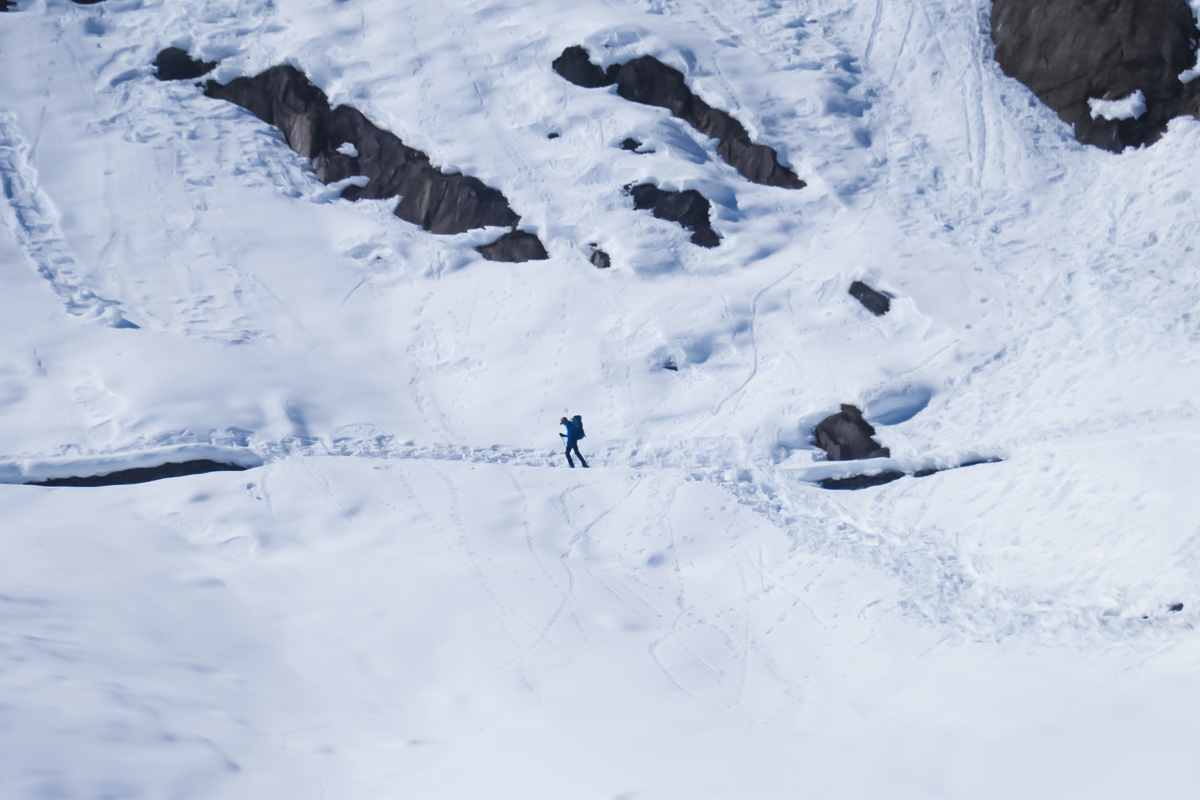
You’ve to go through the different climatic zones in the Manaslu Circuit trek, so you must be prepared for the unpredictable weather that causes an unusual cold in the high altitudes sometimes. During the off-season like monsoon and winter, extreme coldness, heavy rainfall, heavy snowfall, and hazy sunshine are the parts of the Manaslu Circuit trek that makes your trek more difficult.
Note: The entire Manaslu trek is not that easy to complete but if you explore this region with an experienced company like Footprint Adventure with a success rate of 98% in high mountains, you’ll definitely accomplish this journey.
How is the food and safe drinking water in Manaslu Circuit Trek?
The food during the Manaslu Circuit trek is similar to other popular trekking trails in Nepal. The main highlight dish is the Nepali Dal Bhat set which includes boiled rice, lentil soup, vegetables, and pickle, and if you want you will get meat until Samdo as well during the peak season. Besides this, you will get almost all the popular international and continental cuisine along with some other local tastes in the Manaslu circuit trek.
Normally at breakfast they serve, set breakfast, porridge, omelets, boiled eggs, chapati, pancake, Gurung bread, and muesli. You will get normal coffee, tea, and juice along with breakfast.
During Lunchtime, you can either order Dal Bhat Set, or fry rice, pasta, spaghetti, macaroni, dumplings, and some other light meals. As with breakfast, you can have tea, coffee, and juice anytime.
At Dinner, same as at lunch, you can choose your meal from the menu. If you are used to eating light then you can order chapati and vegetable curry as well. The tea houses serve vegetarian meals, vegan meals, and gluten-free meals as well if required. For those meals, you should inform your guide/trekking leader beforehand. Unlike the popular trekking trails like Annapurna Region and Everest Region, you’ll find limited food items in this region.
Regarding the safe drinking water and normal drinkable water in the Manaslu Circuit trek, there are few options for drinking water. If you have water purification tablets and a water purifier, in that case you can ask for normal water from the hotel/lodges you stay in and drink that directly after the purification. Another option is you can buy the already filtered mineral water from the hotels/tea houses. Also, once you reach higher, you can order hot water in a pot and drink that water instead of a cold one. It would be slightly more expensive than normal water but it’s good for high altitudes.
Besides this, we always recommend bringing some protein bars, chocolates, dry nuts, and candy bars which provide additional energy while trekking. Every day’s camp is longer and you’ve to hike quite, which always requires extra energy for your body.
What is the accommodation in the Manaslu Circuit Trek?
Manaslu Circuit Trek is one of the most popular and renowned trekking trails in the Himalayas of central Nepal. This off-the-beaten trek has a lot of good tea houses at low altitudes and nice lodges with clean and neat rooms at high altitudes. The rooms are cheaper if you eat your meal in the same hotel. Normally all the villages like Dovan, Jagat, Namrung, Sama Gaun, Samdo, and Bhinthang have nice rooms with attached bathrooms sometimes. The accommodation will be a little bit conjugated and sometimes we'll have to share the room with other clients also at Dharamshala. They have only two tea houses in that place and during the peak season, it will be crowded. Afterward, the living places would be on a normal, sharing basis rooms, simple and less interior designs that include the bed with a sleeping mattress, bedsheets, and cushions for your solace. But every teahouse will offer the best hospitality as much as possible.
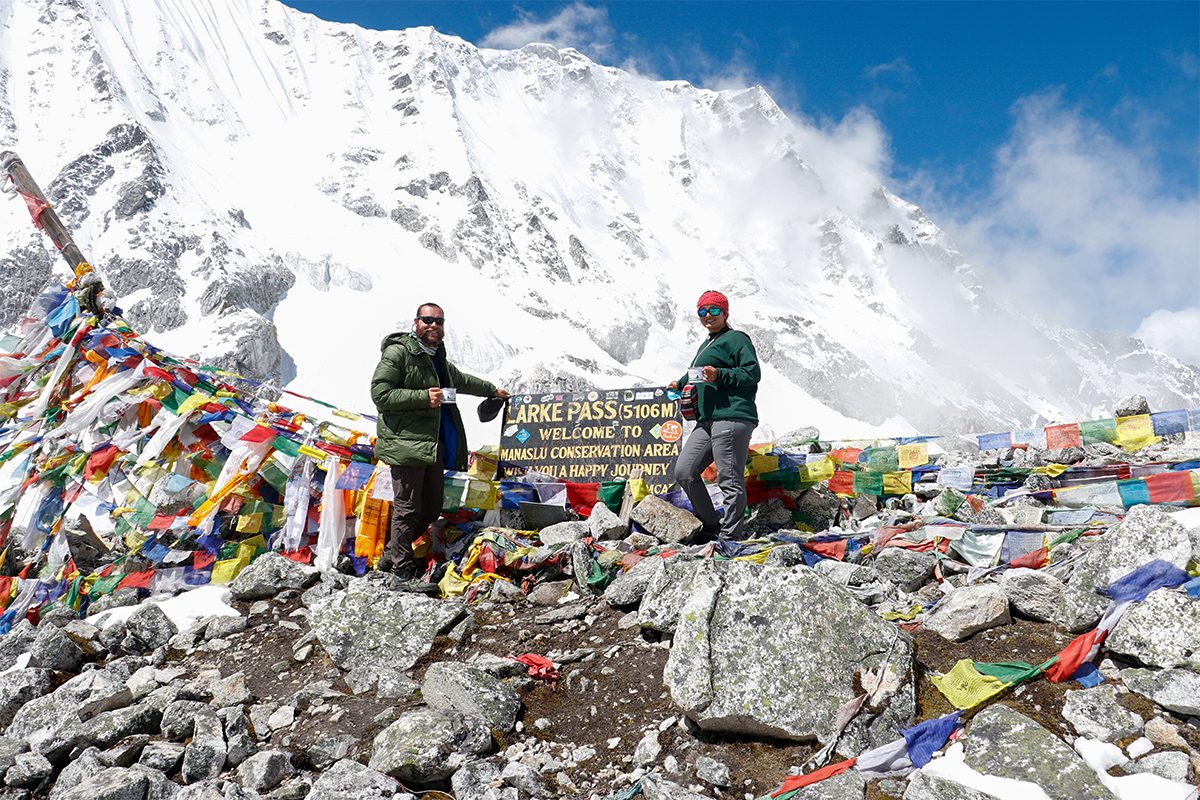
What are the necessary permits & papers for Manaslu Circuit Trek?
The government of Nepal has declared the Manaslu region a special region and you’ve to get a special permit to trek in this region. Due to the open border with Tibet, traditional culture and practices and the availability of rare flora and fauna in the region is the major reason behind the declaration of the restricted area. Besides the special permit, you’ve to obtain the MCAP ( Permit for Manaslu Conservation Area) and ACAP ( Permit for Annapurna Conservation Area) to trek in this region. The cost of the special permit is different in different seasons and the days you’ll stay in this region. The cost for the ACAP and MCAP are fixed for foreigners. The details of the different permits for the Manaslu Circuit trek are listed below:
Manaslu Restricted Area Permit
Manaslu Restricted Permit is a special permit that is issued by the Government of Nepal to preserve and promote the authenticity of the Manaslu region. The cost of the permit is variable and it changes according to the change of season and the number of days you will be staying between the Jagat to Samdo.
- September to November 100USD for 1st seven days and 15 USD extra per person day after there.
- December to August 75USD for 1st seven days and 10USD extra per person for the day after there
MCAP (Manaslu Conservation Area Permit)
MCAP card is another important document to obtain in your Manaslu Circuit trek. From the check post of Arughat, Gorkha, you’ve to check the MCAP permit to get permission in the Manaslu region. The cost of an MCAP permit remains constant throughout the year. If you are traveling through the local travel agency, they will arrange all the necessary permits and access to get inside the Manaslu Region. Trekkers can get an MCAP and ACAP entry permit and TIMS card by submitting a copy of their passport and two passport-size photographs.
ACAP (Annapurna Conservation Area Permit)
Like an MCAP permit, it’s another necessary document that you’ve to reach the summit after crossing the Larkey la pass. Up to the top of Larkey, you’ll be in Gorkha district which is covered by the Manaslu Conservation Area and after Larkey Pass, you’ll touch down the Manang district, which is covered by the Annapurna Conservation Area. So, ACAP is also required during the Manaslu Circuit trek. Like MCAP, the cost of the ACAP permit also remains the same for the entire year.
Permit for SAARC Nationals
- ACAP Permit Fees Rs 1000 ( ~9USD)
- MCAP Permit Fees Rs 1000 ( ~ 9USD)
Permit cost for other nationals
- ACAP Permit Fees Rs 3000 (~ 27 USD)
- MCAP Permit Fees Rs 3000 ( ~ 27USD)
All the required permits MCAP, ACAP, and special permit are valid for single entry to the region and you must carry all the permits during the trek. These entry permits are non-transferable and non-refundable.
Is travel insurance necessary for Manaslu Circuit Trek?
When you are hiking or traveling in high altitudes, your travel insurance is very important for your safety. Travel insurance is one of the most needed documents for trekking in the high Himalayas all over Nepal. Manaslu Circuit Trek is a moderately difficult high-altitude trek, where you’ve to cross the altitude above 5,000 m. Thus, if travelers, unfortunately, face any kind of consequences while trekking, that insurance might be the best for you. It saves you from paying a huge amount at once, so we request all travelers to get travel insurance before heading to Nepal for trekking and any kind of adventurous activity. Besides this, make sure that your insurance policy also covers emergency helicopter evacuation, and medical expenses and that policy covers at least 6,000m altitude. Also, keep in mind that high altitude is not a standard policy on travel insurance, you must mention the altitude separately while buying the insurance policy for Manaslu Circuit trekking.
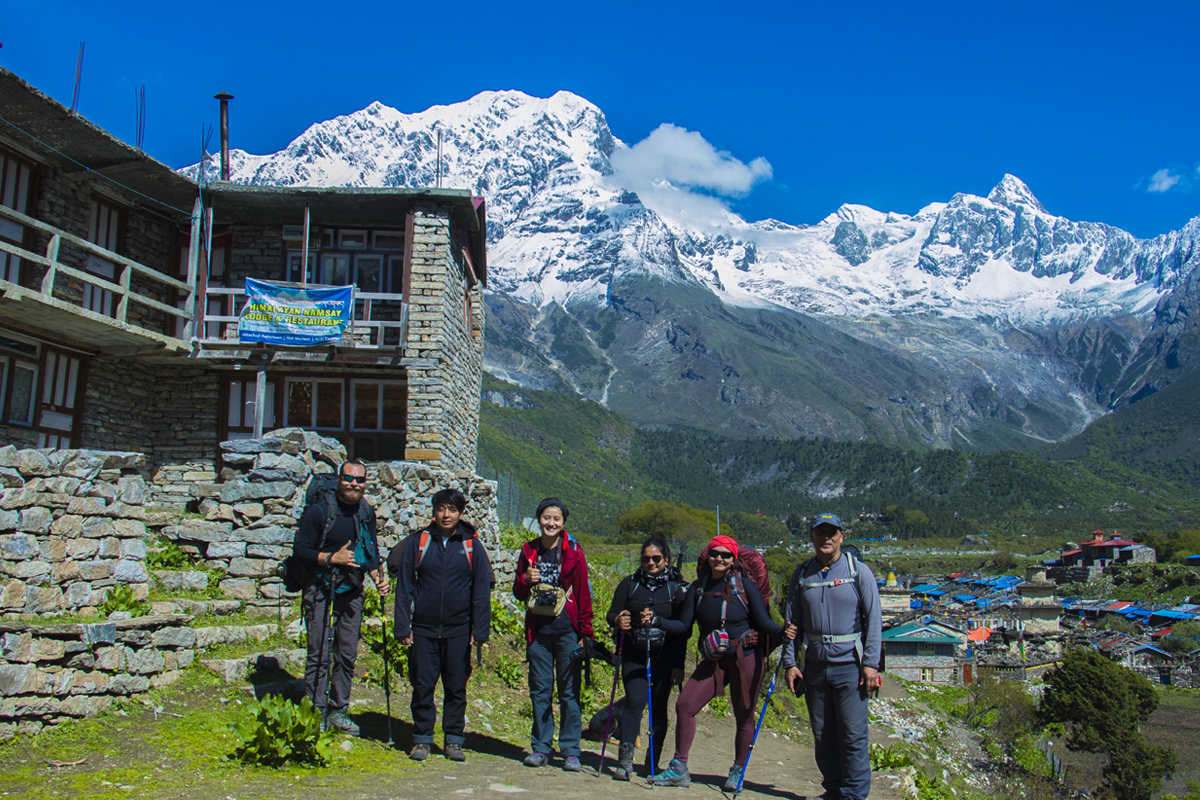
What are the internet, electricity, and mobile network facility in Manaslu Trek?
Wifi is available until Samdo village and after crossing Dharamshala, you’ll get the wifi access again from Bimthang. Similarly, phone charges are also available in most of the lodges so, you can purchase a sim card of (Nepal Telecom Card ) NTC which works in most of the places. You can also find the reception phone from Machha Khola, Jagat, Namrung, Samagaun, Tilije, and Dharapani up to Besisahar. When the normal wifi/internet is not working, you can easily use the mobile network for both internet and phone calls from the SIM card directly. For all these services, the hotels, guest houses, and tea houses charge some amount for wifi, charging your devices and cameras. The charges would range from Rs 400 to Rs 600 depending on the altitude variation.
Solo travel or without a guide is possible in Manaslu Circuit Trek?
Well, the quick answer in one sentence is no because of the guideline of the government of Nepal, the Manaslu region is considered a restricted region of Nepal. You must go through the local travel agency with a guide and porter and it’s mandatory. This means that even a solo trek in Manaslu is not possible just with a guide only. The group should always have more than two personnel to get the special permit. Though, if you are solo and willing to go to the Manaslu, then Footprint Adventure will manage another group or tie up you with another group in your flexible time.
Besides this fact, we don’t suggest any trekkers go alone or without any guidance in high mountain trekking like Annapurna Region, Everest Region, and any other parts of Nepal. You may get lost, you may not be aware of the culture, religion, and traditions of the mountain people, you may not be fully aware of altitude sickness, and you may not know about the other consequences that can happen while trekking on high mountains such as the Manaslu region. The higher you hike, the villages, lodges, and other information will be less and if anything will happen you’ll feel helpless. For such a situation, your guide will help you to take the necessary precautions that ultimately help you to reach your destination. Local guides also show you the proper trails, give you the idea of daily walking, distance, time, and condition of trekking trails along with the best things of Manaslu Region, the name of the mountains, people who live in that area, their culture, and other necessary information regarding this trail.
What is the packing list for the Manaslu Circuit Trek?
Since Manaslu Circuit Trek is moderately difficult graded trekking in the Manaslu region. Make sure that you are carrying enough stuff that is required while trekking, and do not bring which is not necessary as well. Proper management of trekking gears and equipment is the most essential part of this trek. While packing, you’ve to understand that packing a list can either give you a good time or end up making you miserable. Also, remember, at Manaslu, you’ll trek so, do not bring any other climbing gear which is not required for you. You don’t need that many things as you are going to stay in the tea house every night. Normally for clothing, you can bring a pair of the base layers, second layer, and outermost layer. Here is the most essential packing list which is suitable for almost all the trekking trails in Nepal including the Manaslu Circuit trek,
- A pair of hiking trousers and shorts.
- Light polyester trekking shirts.
- A waterproof shell jacket and raincoat are also helpful for you. Sometimes there might be chances of unexpected rainfall even in the normal trekking season.
- Required underwear and at least 4 pairs of socks.
- Gloves, hat, neck, and mount cover. So that you can save your face from the heavy wind.
- A pair of hiking shoes, sunglasses, a pair of sandals, a trekking bag, and your other regular medicine if you are taking any.
- Sleeping bag, toilet paper, towel, toothpaste, toothbrush, suncream, and hand sanitizer for your regular use.
- Also, the most useful thing is a water bottle and water purifier if you want to drink regular water.
Acute Mountain Sickness and Preventive Measures during the Manaslu Trek
High altitude sickness is very common when you are hiking above the 3,500 m altitude. During your Manaslu Circuit trek, you’ve to cross the longest trekking pass in Nepal; Larkey la pass with an altitude of 5,106 m. Acute Mountain Sickness (AMS) is not a common situation, it occurs when your body is not able to adjust to the higher elevation, climate, and environment. So, AMS differs from one person to another, the strength of sickness also differs from person to person according to the age of people, normal health status, physical strength, and experience of prior hiking in high mountains.
In Manaslu Circuit Trek, many people feel the symptoms of AMS. If the symptoms of the illness are not taken care of properly, the situation can even turn critical. That’s why we always suggest travelers trek with guides and local travel agencies.
Some Common Symptoms of AMS
- Headache ( both side and one side of the head)
- Loss of appetite
- Nausea and vomiting sometimes.
- Tiredness and dizziness.
- Feel discomfort while sleeping.
- Increase the heart rate and shortness of breathing.
Common Prevention
- Keep your body hydrated and drink at least 4-5 liters of water every day when you cross above 3,000m
- Take plenty of rest after finishing your daily hike.
- Consume enough food and calories while trekking.
- Wear enough and make your body warm.
- When you feel most of the AMS symptoms, descend to a lower altitude as soon as possible.
- Ascend slowly and acclimatize properly according to the needs of your body.
- Travel with a local guide and travel agency so that they will help you to trail for all the possible consequences.
- There are few medicines like Diamox that help to prevent sickness. But, remember one thing, before taking any drugs related to AMS consult with related doctors or medical experts.
Conclusion
These are the essential aspects for one who is planning for a trip to Manaslu Circuit trek. This comprehensive guidebook will give you an idea that many do not precisely fit when you find yourself on the trek. This Manaslu Circuit trek guidebook will be useful in arranging and getting ready for your upcoming adventure in Nepal, especially in high-altitude trekking. The complete Manaslu Circuit trek is an incredible excursion in the remote part of Nepal where you can experience the breathtaking views of the snowy mountains, valleys, landscapes, and glacial scenery. For more details and a customized itinerary of the Manaslu Circuit trek, feel free to contact us anytime.









